Defects in Electron Beam Melted Ti-6Al-4V: Fatigue Life Prediction Using Experimental Data and Extreme Value Statistics
Abstract
1. Introduction
2. Materials and Methods
2.1. Statistical Simulations of Defect Size Distributions
2.2. Fatigue Crack Growth Calculations
2.3. Fatigue Life Predictions
3. Results
3.1. Fatigue Testing and Fractography
3.2. X-ray Computed Tomography Data
3.3. Statistical Fitting
3.4. Fatigue Life Prediction
4. Discussion
4.1. Defect Distribution Simulations
4.1.1. Selecting a Cut-Off
4.1.2. Effect of Investigated Volume
4.2. FCG Calculations
Crack Case
4.3. Fatigue Life Prediction
4.3.1. Deterministic Prediction from Fractography
4.3.2. Deterministic Prediction from XCT
4.3.3. Probabilistic Prediction from XCT
5. Conclusions
Author Contributions
Funding
Data Availability Statement
Acknowledgments
Conflicts of Interest
References
- Wohlers, T. Wohlers Report 2018; Technical Report; Wohler Associates: Fort Collins, CO, USA, 2018. [Google Scholar]
- Solberg, K.; Berto, F. What is going on with fatigue of additively manufactured metals? Mater. Des. Process. Commun. 2019, e84. [Google Scholar] [CrossRef]
- Greitemeier, D.; Donne, C.D.; Syassen, F.; Eufinger, J.; Melz, T. Effect of surface roughness on fatigue performance of additive manufactured Ti–6Al–4V. Mater. Sci. Technol. 2016, 32, 629–634. [Google Scholar] [CrossRef]
- Li, P.; Warner, D.H.; Fatemi, A.; Phan, N. Critical assessment of the fatigue performance of additively manufactured Ti–6Al–4V and perspective for future research. Int. J. Fatigue 2016, 85, 130–143. [Google Scholar] [CrossRef]
- Draper, S.L.; Lerch, B.A.; Telesman, J.; Martin, R.E.; Locci, I.E.; Garg, A.; Ring, A.J. Materials Characterization of Electron Beam Melted Ti-6Al-4V; Technical Report; National Aeronautics and Space Administration, Glenn Research Center: Cleveland, OH, USA, 2016.
- Romano, S.; Nezhadfar, P.D.; Shamsaei, N.; Seifi, M.; Beretta, S. High cycle fatigue behavior and life prediction for additively manufactured 17-4 PH stainless steel: Effect of sub-surface porosity and surface roughness. Theor. Appl. Fract. Mech. 2020, 106, 102477. [Google Scholar] [CrossRef]
- Seifi, M.; Salem, A.; Beuth, J.; Harrysson, O.; Lewandowski, J. Overview of Materials Qualification Needs for Metal Additive Manufacturing. JOM 2016, 68, 747–764. [Google Scholar] [CrossRef]
- Beretta, S.; Romano, S. A comparison of fatigue strength sensitivity to defects for materials manufactured by AM or traditional processes. Int. J. Fatigue 2017, 94, 178–191. [Google Scholar] [CrossRef]
- Persenot, T.; Buffiere, J.Y.; Maire, E.; Dendievel, R.; Martin, G. Fatigue properties of EBM as-built and chemically etched thin parts. Procedia Struct. Integr. 2017, 7, 158–165. [Google Scholar] [CrossRef]
- Leuders, S.; Vollmer, M.; Brenne, F.; Tröster, T.; Niendorf, T. Fatigue Strength Prediction for Titanium Alloy TiAl6V4 Manufactured by Selective Laser Melting. Metall. Mater. Trans. A 2015, 46, 3816–3823. [Google Scholar] [CrossRef]
- Le, V.D.; Pessard, E.; Morel, F.; Edy, F. Influence of porosity on the fatigue behavior of additively fabricated TA6V alloys. In Proceedings of the 12th International Fatigue Congress (FATIGUE 2018), Poitiers, France, 27 May–1 June 2018; EDP Sciences: Les Ulis, France, 2018; Volume 165, p. 02008. [Google Scholar] [CrossRef][Green Version]
- Hu, Y.N.; Wu, S.C.; Wu, Z.K.; Zhong, X.L.; Ahmed, S.; Karabal, S.; Xiao, X.H.; Zhang, H.O.; Withers, P.J. A new approach to correlate the defect population with the fatigue life of selective laser melted Ti-6Al-4V alloy. Int. J. Fatigue 2020, 136, 105584. [Google Scholar] [CrossRef]
- Romano, S.; Patriarca, L.; Foletti, S.; Beretta, S. LCF behavior and a comprehensive life prediction model for AlSi10Mg obtained by SLM. Int. J. Fatigue 2018, 117, 47–62. [Google Scholar] [CrossRef]
- Romano, S.; Brückner-Foit, A.; Brandão, A.; Gumpinger, J.; Ghidini, T.; Beretta, S. Fatigue properties of AlSi10Mg obtained by additive manufacturing: Defect-based modeling and prediction of fatigue strength. Eng. Fract. Mech. 2017. [Google Scholar] [CrossRef]
- Tang, M.; Pistorius, P.C. Fatigue life prediction for AlSi10Mg components produced by selective laser melting. Int. J. Fatigue 2019, 125, 479–490. [Google Scholar] [CrossRef]
- Jones, R.; Michopoulos, J.G.; Iliopoulos, A.P.; Raman, R.K.S.; Phan, N.; Nguyen, T. Representing crack growth in additively manufactured Ti-6Al-4V. Int. J. Fatigue 2018, 116, 610–622. [Google Scholar] [CrossRef]
- Li, P.; Warner, D.H.; Phan, N. Predicting the fatigue performance of an additively manufactured Ti-6Al-4V component from witness coupon behavior. Addit. Manuf. 2020, 35, 101230. [Google Scholar] [CrossRef]
- Seifi, M.; Salem, A.; Satko, D.; Shaffer, J.; Lewandowski, J.J. Defect distribution and microstructure heterogeneity effects on fracture resistance and fatigue behavior of EBM Ti–6Al–4V. Int. J. Fatigue 2017, 94, 263–287. [Google Scholar] [CrossRef]
- Murakami, Y.; Endo, M. Quantitative evaluation of fatigue strength of metals containing various small defects or cracks. Eng. Fract. Mech. 1983, 17, 1–15. [Google Scholar] [CrossRef]
- Sandell, V.; Hansson, T.; Forsberg, F.; Lycksam, H.; Åkerfeldt, P.; Antti, M.L. X-ray Micro Tomography Study of Internal Defects of Electron Beam Melted Ti6Al4V and Their Effect on Fatigue Behavior. MATEC Web Conf. 2020, 321, 03029. [Google Scholar] [CrossRef]
- Liu, Q.C.; Elambasseril, J.; Sun, S.J.; Leary, M.; Brandt, M.; Sharp, P.K. The effect of manufacturing defects on the fatigue behavior of Ti-6Al-4V specimens fabricated using selective laser melting. In Advanced Materials Research; Trans Tech Publ: Stafa-Zurich, Switzerland, 2014; Volume 891, pp. 1519–1524. [Google Scholar] [CrossRef]
- Yadollahi, A.; Shamsaei, N. Additive manufacturing of fatigue resistant materials: Challenges and opportunities. Int. J. Fatigue 2017, 98, 14–31. [Google Scholar] [CrossRef]
- Du Plessis, A.; Yadroitsava, I.; Yadroitsev, I. Effects of defects on mechanical properties in metal additive manufacturing: A review focusing on X-ray tomography insights. Mater. Des. 2020, 187, 108385. [Google Scholar] [CrossRef]
- Murakami, Y. Metal Fatigue: Effects of Small Defects and Nonmetallic Inclusions, 1st ed.; Elsevier Science: Amsterdam, the Netherlands, 2002. [Google Scholar]
- Romano, S.; Brandão, A.; Gumpinger, J.; Gschweitl, M.; Beretta, S. Qualification of AM parts: Extreme value statistics applied to tomographic measurements. Mater. Des. 2017, 131, 32–48. [Google Scholar] [CrossRef]
- Romano, S.; Abel, A.; Gumpinger, J.; Brandão, A.D.; Beretta, S. Quality control of AlSi10Mg produced by SLM: Metallography versus CT scans for critical defect size assessment. Addit. Manuf. 2019, 28, 394–405. [Google Scholar] [CrossRef]
- Sanaei, N.; Fatemi, A. Defects in Additive Manufactured Metals and Their Effect on Fatigue Performance: A State-of-the-Art Review. Prog. Mater. Sci. 2020, 100724. [Google Scholar] [CrossRef]
- Ng, G.K.L.; Jarfors, A.E.W.; Bi, G.; Zheng, H.Y. Porosity formation and gas bubble retention in laser metal deposition. Appl. Phys. A 2009, 97, 641. [Google Scholar] [CrossRef]
- Hrabe, N.; Quinn, T. Effects of processing on microstructure and mechanical properties of a titanium alloy (Ti–6Al–4V) fabricated using electron beam melting (EBM), part 1: Distance from build plate and part size. Mater. Sci. Eng. A 2013, 573, 264–270. [Google Scholar] [CrossRef]
- Cunningham, R.; Narra, S.P.; Montgomery, C.; Beuth, J.; Rollett, A.D. Synchrotron-Based X-ray Microtomography Characterization of the Effect of Processing Variables on Porosity Formation in Laser Power-Bed Additive Manufacturing of Ti-6Al-4V. JOM 2017, 69, 479–484. [Google Scholar] [CrossRef]
- Hojjatzadeh, S.M.H.; Parab, N.D.; Guo, Q.; Qu, M.; Xiong, L.; Zhao, C.; Escano, L.I.; Fezzaa, K.; Everhart, W.; Sun, T.; et al. Direct observation of pore formation mechanisms during LPBF additive manufacturing process and high energy density laser welding. Int. J. Mach. Tools Manuf. 2020, 103555. [Google Scholar] [CrossRef]
- Hrabe, N.; Gnäupel-Herold, T.; Quinn, T. Fatigue properties of a titanium alloy (Ti–6Al–4V) fabricated via electron beam melting (EBM): Effects of internal defects and residual stress. Int. J. Fatigue 2016, 94, 202–210. [Google Scholar] [CrossRef]
- Baldissera, M.R.; Rios, P.R.; Hein, L.R.O.; Sandim, H.R.Z. Three-dimensional characterization of pores in Ti-6Al-4V alloy. Mater. Res. 2011, 14, 102–106. [Google Scholar] [CrossRef]
- Du Plessis, A.; Yadroitsev, I.; Yadroitsava, I.; Roux, S.G.L. X-ray Microcomputed Tomography in Additive Manufacturing: A Review of the Current Technology and Applications. 3D Print. Addit. Manuf. 2018, 5, 227–247. [Google Scholar] [CrossRef]
- Standard Practice for Extreme Value Analysis of Nonmetallic Inclusions in Steel and Other Microstructural Features. In Standard ASTM FE2283-08; ASTM International: West Conshohocken, PA, USA, 2014.
- Murakami, Y.; Beretta, S. Small Defects and Inhomogeneities in Fatigue Strength: Experiments, Models and Statistical Implications. Extremes 1999, 2, 123–147. [Google Scholar] [CrossRef]
- Reiss, R.D.; Thomas, M. Statistical Analysis of Extreme Values; Birkhäuser Verlag: Basel, Switzerland, 2007; Chapter 5. [Google Scholar]
- Standard Specification for Additive Manufacturing Titanium-6 Aluminum-4 Vanadium ELI (Extra Low Interstitial) with Powder Bed Fusion. In Standard ASTM F3001-14; ASTM International: West Conshohocken, PA, USA, 2014.
- Dragonfly 4.0. In Reference Manual; Object Research Systems: Montreal, QC, Canada, 2019.
- NASGRO 9.1. In Reference Manual; Southwest Research Institute: San Antonio, TX, USA, 2019.
- Galarraga, H.; Warren, R.J.; Lados, D.A.; Dehoff, R.R.; Kirka, M.M. Fatigue crack growth mechanisms at the microstructure scale in as-fabricated and heat treated Ti-6Al-4V ELI manufactured by electron beam melting (EBM). Eng. Fract. Mech. 2017, 176, 263–280. [Google Scholar] [CrossRef]
- Romano, S.; Miccoli, S.; Beretta, S. A new FE post-processor for probabilistic fatigue assessment in the presence of defects and its application to AM parts. Int. J. Fatigue 2019, 125, 324–341. [Google Scholar] [CrossRef]
- Andreau, O.; Pessard, E.; Koutiri, I.; Penot, J.D.; Dupuy, C.; Saintier, N.; Peyre, P. A competition between the contour and hatching zones on the high cycle fatigue behavior of a 316L stainless steel: Analyzed using X-ray computed tomography. Mater. Sci. Eng. A 2019, 757, 146–159. [Google Scholar] [CrossRef]
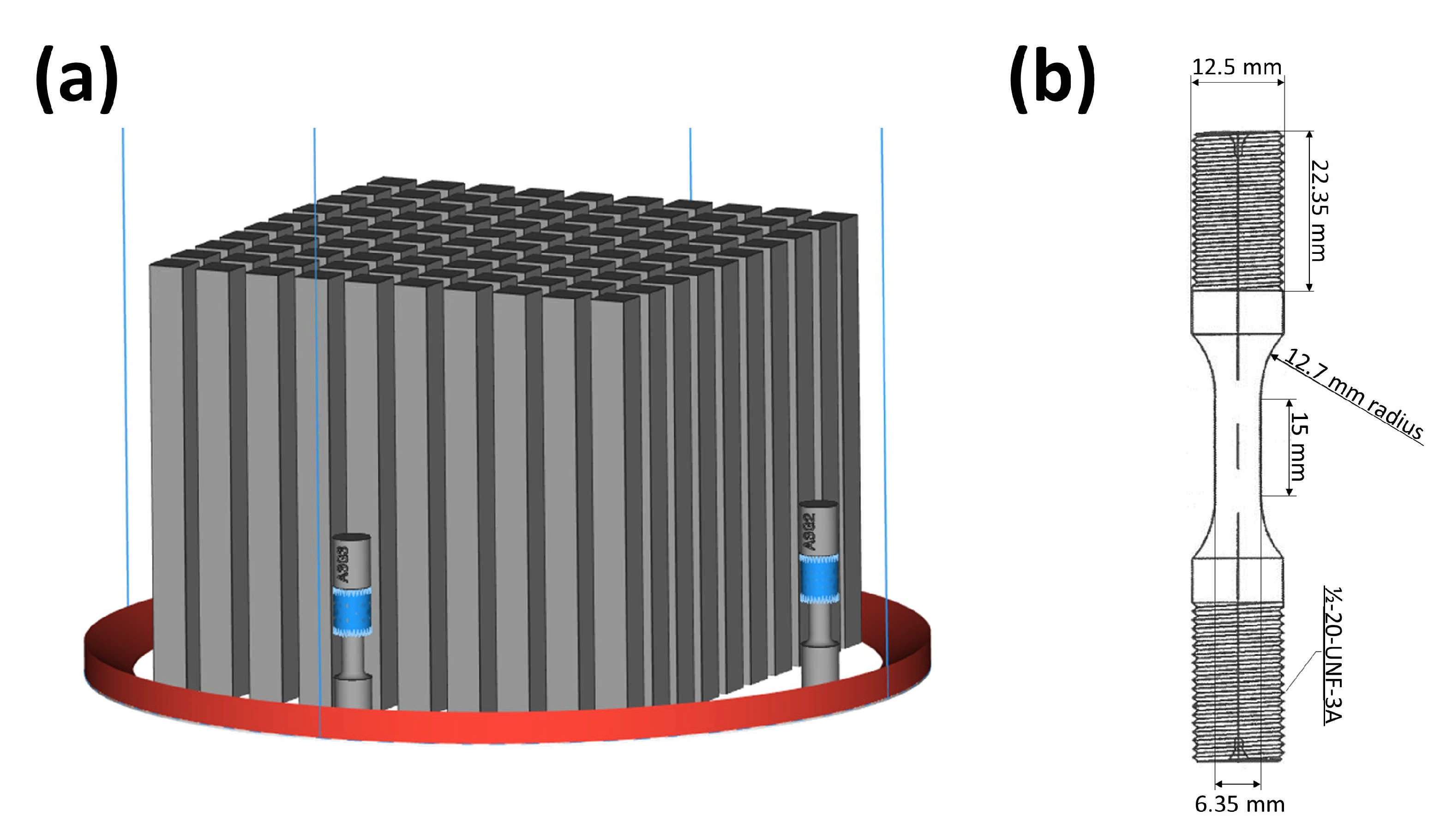



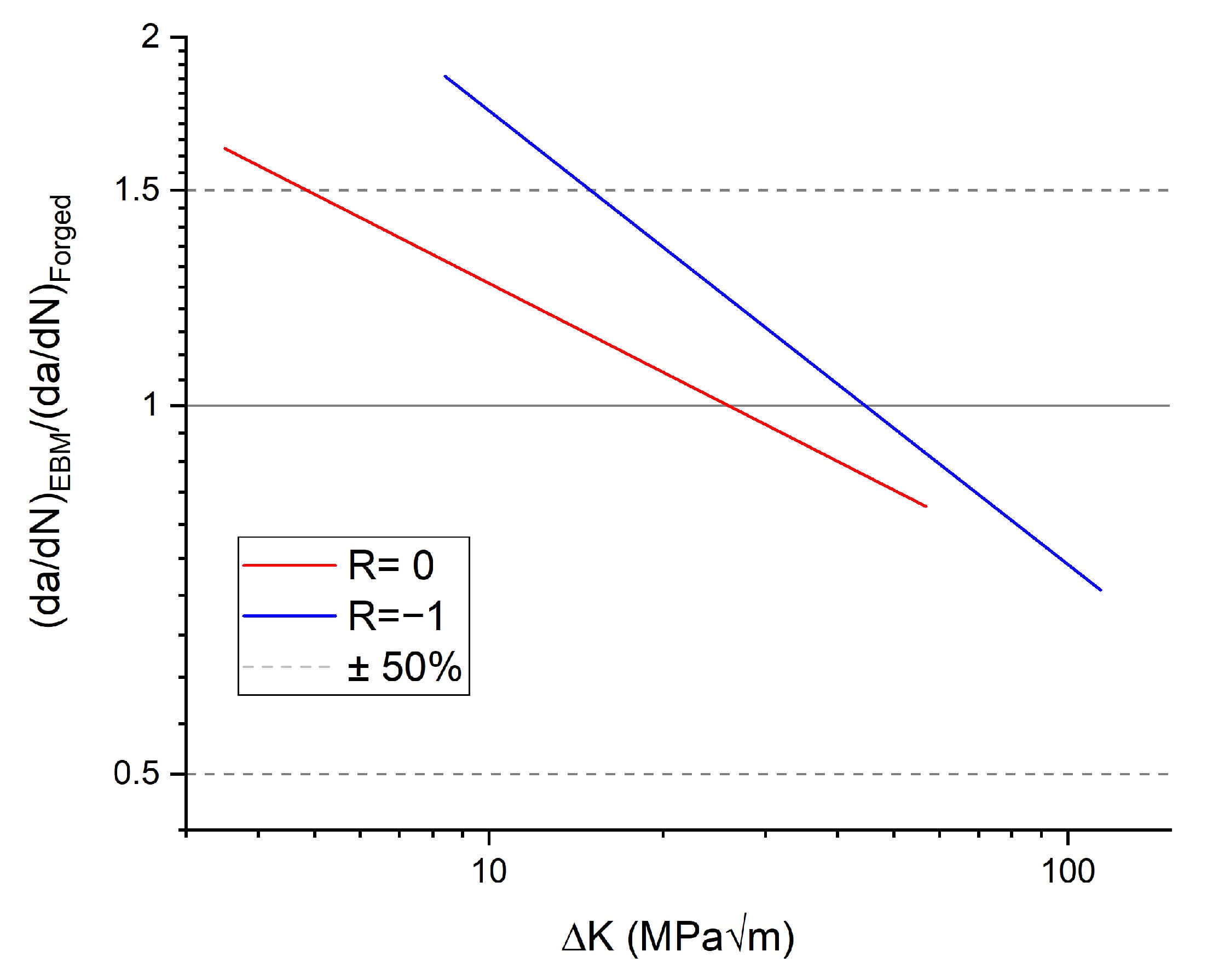

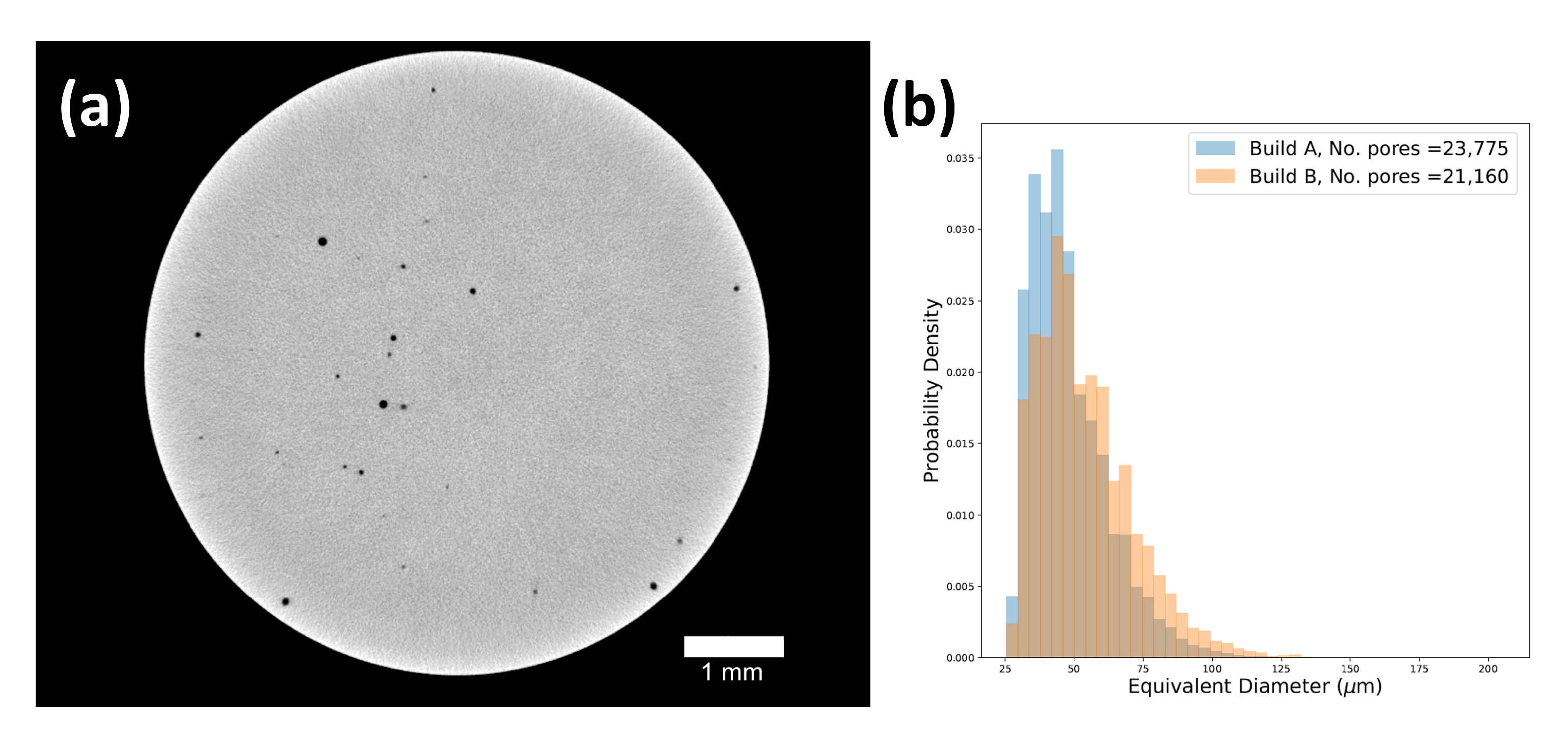
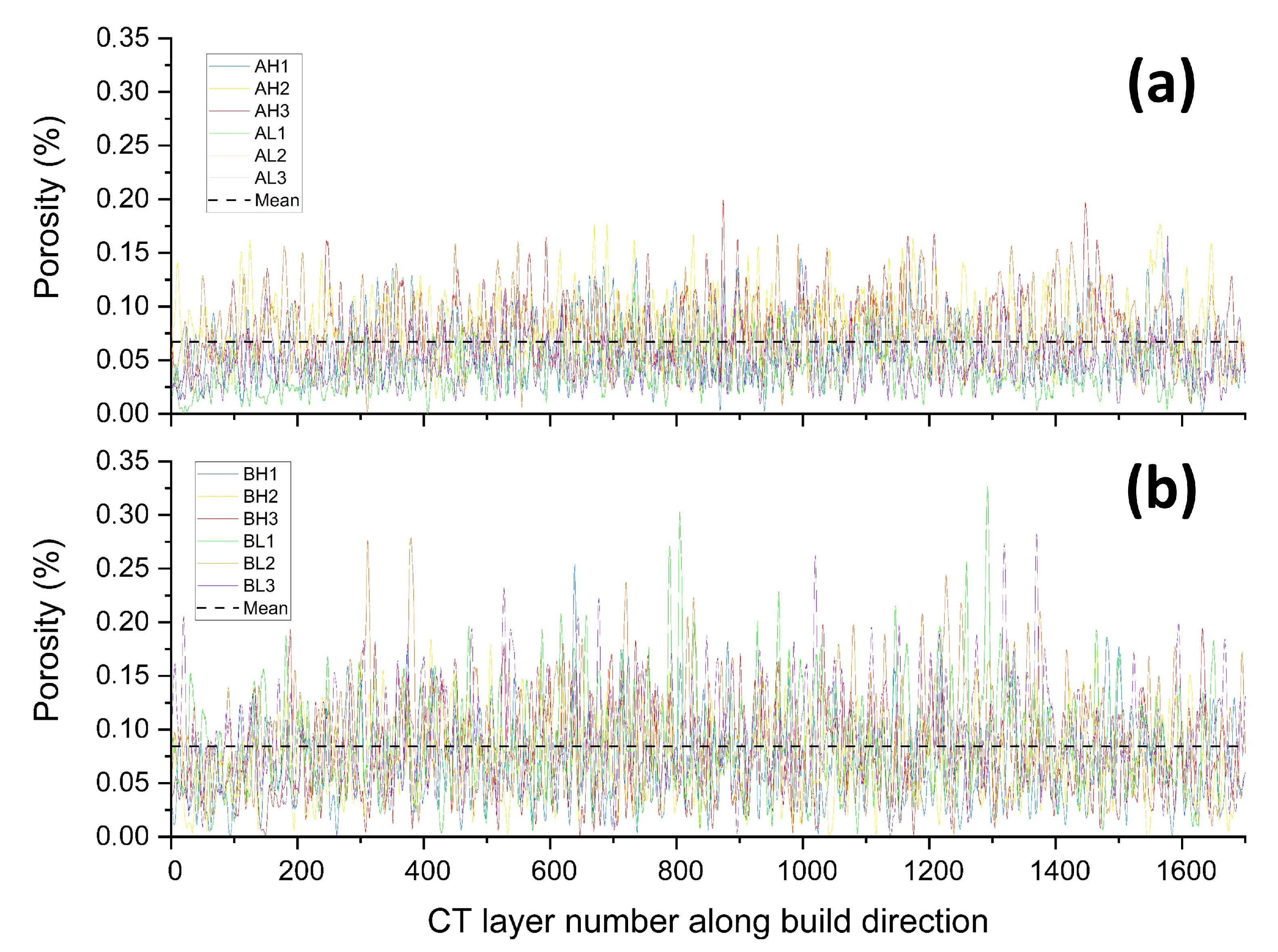
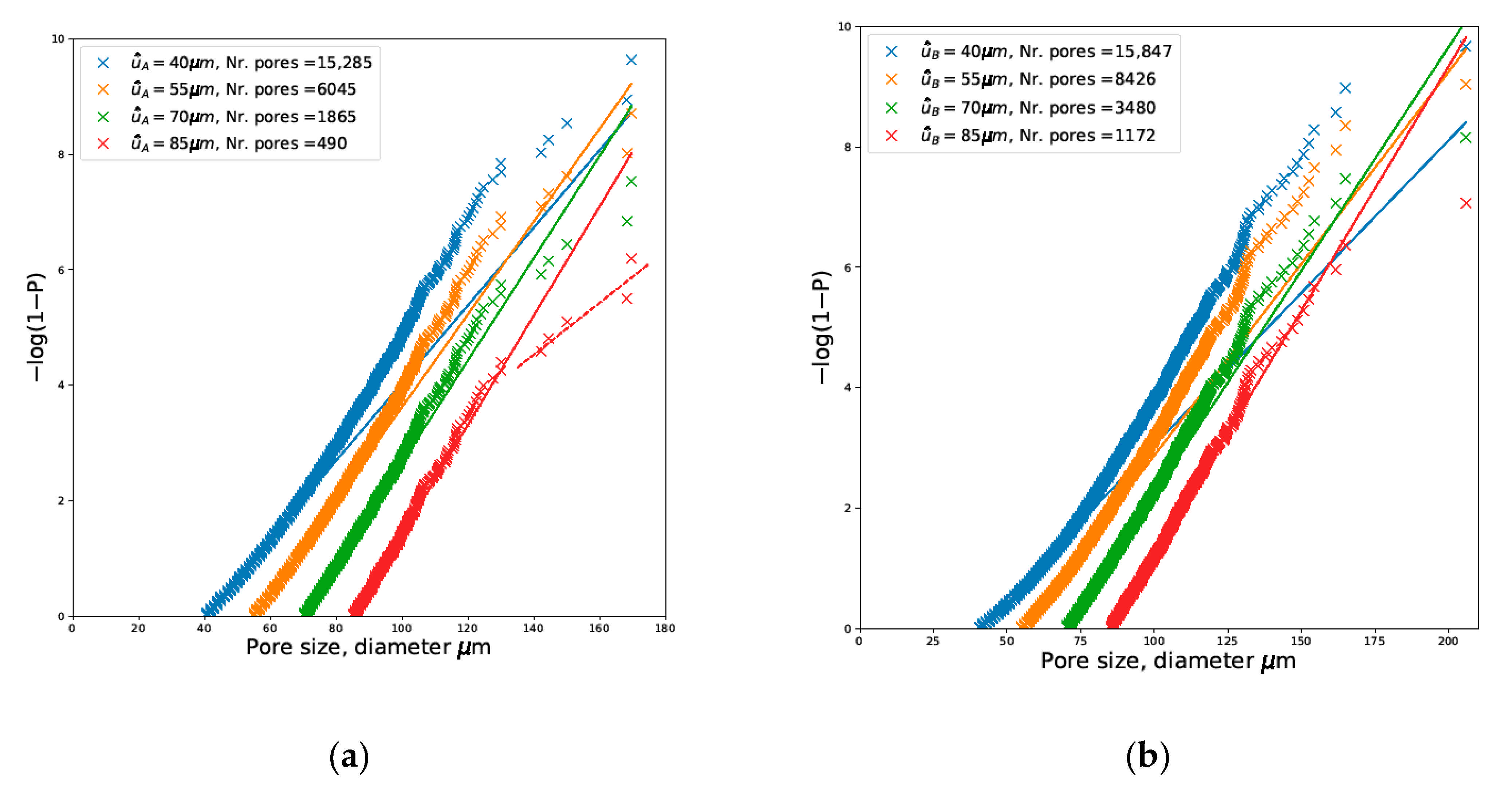

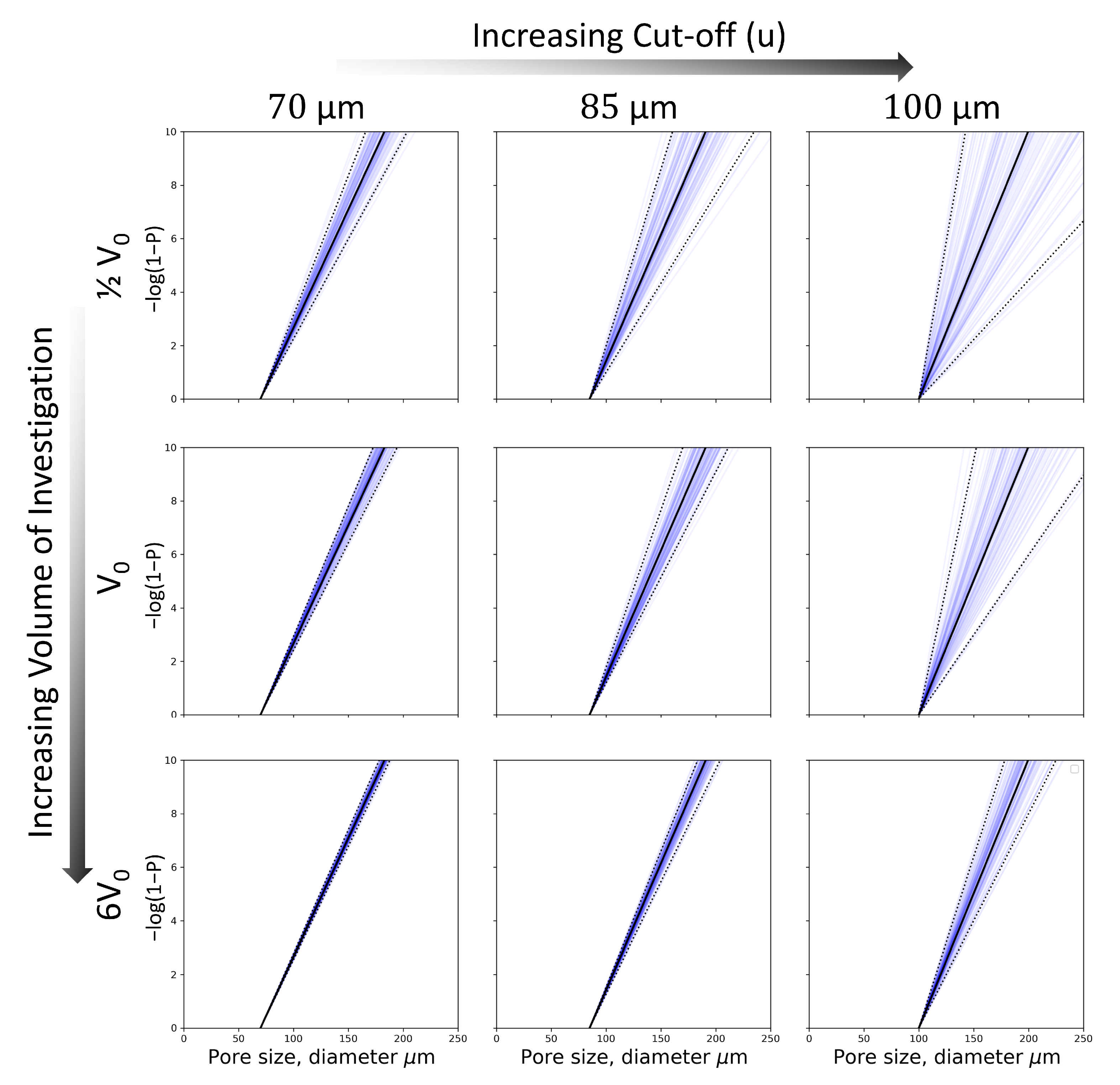
| Element | C | O | N | H | Fe | Al | V | Y | Other | Ti |
|---|---|---|---|---|---|---|---|---|---|---|
| ASTM F3001 | <0.08 | <0.13 | <0.05 | <0.012 | <0.25 | 5.50–6.50 | 3.50–4.50 | <0.005 | <0.40 | Balance |
| As-delivered | 0.01 | 0.09 | 0.02 | 0.002 | 0.18 | 6.35 | 4.01 | <0.001 | <0.40 | Balance |
| Field of View (mm) | Voxel Size (μm) | Tube Voltage (kV) | Tube Output (W) | # of Projections | Exposure Time (s) | Scan Time (h) |
|---|---|---|---|---|---|---|
| 17.4 | 8.5 | 140 | 10 | 1601 | 9 | 5.5 |
| Specimens | (MPa) | (MPa) | Initiator Radius (r) (μm) | Distance from Surface (h) (μm) | r/h | Actual Life (A) (# of Cycles) | Predicted Life (P) (# of Cycles) | A/P |
|---|---|---|---|---|---|---|---|---|
| R = −1 | ||||||||
| AH1 | 596 | −633 | 41.8 | 51.7 | 0.809 | 18,340 | 17,359 | 1.06 |
| AH2 | 605 | −616 | 38.6 | 51.4 | 0.751 | 18,975 | 17,295 | 1.10 |
| AH3 * | 619 | −608 | 34.4 | 17.6 | 1.96 | 18,712 | 25,172 | 0.743 |
| AL1 † | 605 | −614 | - | - | - | 12,334 | 9690 | 1.27 |
| AL2 | 595 | −608 | 40.0 | 52.4 | 0.763 | 20,763 | 17,865 | 1.16 |
| AL3 | 588 | −633 | 50.6 | 50.7 | 0.998 | 19,396 | 16,881 | 1.15 |
| BH1 * | 608 | −618 | 59.3 | 0 | ∞ | 16,935 | 36,395 | 0.465 |
| BH2 | 587 | −655 | 45.2 | 39.8 | 1.14 | 18,672 | 19,465 | 0.959 |
| BH3 * | 619 | −614 | 49.9 | 23.2 | 2.15 | 15,642 | 19,145 | 0.817 |
| BL1 | 595 | −628 | 54.0 | 44.7 | 1.21 | 15,514 | 16,702 | 0.929 |
| BL2 | 584 | −653 | 58.3 | 44.9 | 1.30 | 16,022 | 16,778 | 0.955 |
| BL3 * | 607 | −616 | 39.7 | 44.1 | 0.899 | 16,527 | 13,303 | 1.24 |
| R = 0 | ||||||||
| AH4 † | 500 | 0 | - | - | - | 45,497 | 27,455 | 1.66 |
| AL4 † | 500 | 0 | - | - | - | 57,909 | 33,328 | 1.74 |
| BH4 | 500 | 0 | 64.1 | 0 | ∞ | 151,075 | 92,230 | 1.64 |
| BL4 | 500 | 0 | 78.5 | 169 | 0.466 | 80,959 | 19,985 | 4.05 |
| Investigated Volume (mm3) | Defects (#) | Porosity (%) | |
|---|---|---|---|
| Build A | 2769.1 | 20,486 | 0.0672 |
| Build B | 2769.5 | 22,803 | 0.0844 |
| (μm) | (μm) | ||
|---|---|---|---|
| Build A | 70 | 11.295 | 192.2 |
| Build B | 85 | 12.31 | 211.4 |
Publisher’s Note: MDPI stays neutral with regard to jurisdictional claims in published maps and institutional affiliations. |
© 2021 by the authors. Licensee MDPI, Basel, Switzerland. This article is an open access article distributed under the terms and conditions of the Creative Commons Attribution (CC BY) license (http://creativecommons.org/licenses/by/4.0/).
Share and Cite
Sandell, V.; Hansson, T.; Roychowdhury, S.; Månsson, T.; Delin, M.; Åkerfeldt, P.; Antti, M.-L. Defects in Electron Beam Melted Ti-6Al-4V: Fatigue Life Prediction Using Experimental Data and Extreme Value Statistics. Materials 2021, 14, 640. https://doi.org/10.3390/ma14030640
Sandell V, Hansson T, Roychowdhury S, Månsson T, Delin M, Åkerfeldt P, Antti M-L. Defects in Electron Beam Melted Ti-6Al-4V: Fatigue Life Prediction Using Experimental Data and Extreme Value Statistics. Materials. 2021; 14(3):640. https://doi.org/10.3390/ma14030640
Chicago/Turabian StyleSandell, Viktor, Thomas Hansson, Sushovan Roychowdhury, Tomas Månsson, Mats Delin, Pia Åkerfeldt, and Marta-Lena Antti. 2021. "Defects in Electron Beam Melted Ti-6Al-4V: Fatigue Life Prediction Using Experimental Data and Extreme Value Statistics" Materials 14, no. 3: 640. https://doi.org/10.3390/ma14030640
APA StyleSandell, V., Hansson, T., Roychowdhury, S., Månsson, T., Delin, M., Åkerfeldt, P., & Antti, M.-L. (2021). Defects in Electron Beam Melted Ti-6Al-4V: Fatigue Life Prediction Using Experimental Data and Extreme Value Statistics. Materials, 14(3), 640. https://doi.org/10.3390/ma14030640







